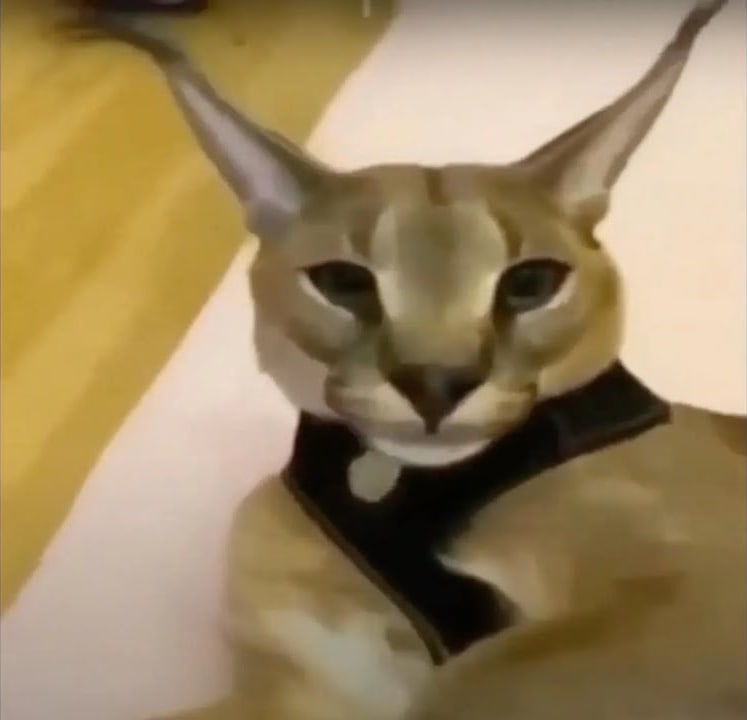
If you’re a fan of the Beluga Cinematic Universe on Discord, you’ve likely seen a few popular Hecker memes. Hecker’s name was originally Heckler, and, according to Urban Dictionary, a heckler is an advanced hacker.1 His name certainly fits his hobby. His breed is a little harder to explain as he doesn’t look like a typical housecat. He has extraordinarily long ears and uniquely shaped eyes. That’s because Hecker is a caracal cat!
Hackers may even relate to caracals as they are experienced hunters, much like themselves. They are stealthy, and some hackers even leave breadcrumbs, like a caracal leaving a scent to mark their territory. Are you a Hecker?
Now that you know that Hecker is a caracal let’s learn more about these unique cats and why they are on the verge of extinction in some areas of the world.

The Caracal
Habitat
Caracals are most comfortable in dry, harsh environments, such as semi-deserts, arid mountains, dry woodlands, or savanna. They are usually found in India, northern and southern Africa, and the Middle East, including Iran, where their numbers are dwindling.
Because their natural habitats are now shrinking due to land development, caracal cats are forced to expand their range to include new terrains they haven’t hunted previously. It also means living near farmland or housing that hadn’t existed before, further threatening the species.

Appearance
The cats are smaller than most wild, exotic cats, with males weighing up to 44 pounds and females weighing as much as 35 pounds. They are agile with long legs and thin, sleek bodies. Their deep golden coat and other characteristics lead biologists and geneticists to believe they have developed a unique lineage from servals and the golden cat species found in Africa.
Their most distinctive feature is their long, pointed ears with tufts of black fur at the ends. These “tassels” can be used to shoo flies away, but the consensus is that they are used to communicate with other caracal cats. Another way caracals communicate is through scent. Like housecats, they have scent glands in their paws and faces, allowing them to mark their territory.
Diet
Because they live in such arid, hot climates, caracals rest during the day and escape the afternoon heat in caves or shaded crevices. They hunt in the evenings or at night, and their diet consists primarily of nocturnal prey. That could be birds just settling down, rodents, gazelles, impalas, and gazelles. A varied diet means adapting their hunting style to the prey they are after. As particularly great bird hunters, they inspired the phrase, “put a cat amongst the pigeons.”
Another way in which caracals are similar to housecats is in the way they hunt. They aren’t fast runners like the cheetah. Instead, they are stealthy, stalking their prey slowly from behind cover and then leaping quickly. They can jump relatively high and are agile even in the air. The cats typically hunt alone, only coming together to mate.

In The Wild
Due to their remote living conditions, the exact populations of caracals are unknown. However, there are signs that their numbers are declining quickly in most, if not all, of their natural habitats. Today, only 5% of their habitat remains untouched, which has undoubtedly affected the species. However, because they are elusive, it will be nearly impossible to determine how many caracals exist in the wild. If caracal populations continue to decline, it could have devastating consequences on the entire food chain in those regions.
In Captivity
As smaller exotic cats, caracals are often desired as pets. However, their nature is to live alone and hunt an area sometimes as large as 200 miles. Even in states where exotic pets are allowed, keeping caracals can be pretty harmful to the cat, whose instincts are anything but to live confined to a small area and be fed a diet inconsistent with what they’d hunt in the wild.
The costs associated with keeping caracal cats are also extremely expensive. The cat can cost tens of thousands of dollars, plus veterinary care for an exotic pet is not cheap. Their food costs will add up quickly. The cats are escape artists because they are rarely comfortable being kept confined, and security systems can be extensive. If your pet escaped, the fines could be unaffordable for some. You may even be liable, or your pet could be euthanized if someone gets hurt.
Keeping caracal cats as pets is typically frowned upon, as they are much happier roaming a savanna. Some caracals that have been bred in captivity or couldn’t survive in their natural habitat are often kept in zoos or cat rescues where their territory can be replicated as closely as possible. Some breeding programs at zoos are designed to eventually release caracals to the wild to bolster their wild populations.

Final Thoughts
Perhaps Hecker’s newly found fame can bring awareness to his wild kin and help promote conservation efforts worldwide. However, in the meantime, we can all enjoy the adventures of Beluga, Hecker, and their various other character friends in the Beluga Cinematic Universe, as well as the unique appearance of Hecker. If you’re interested in learning more about caracal cats, see if your local zoo is lucky enough to keep one of the majestic animals!
See also:
- What Breed of Cat is Ferguson in New Girl? TV Cats!
- What Breed of Cat Was Grumpy Cat? The Interesting Answer!
Featured Image Credit: Characters by Beluga Cinematic Universe. All rights reserved to the copyright owners.





